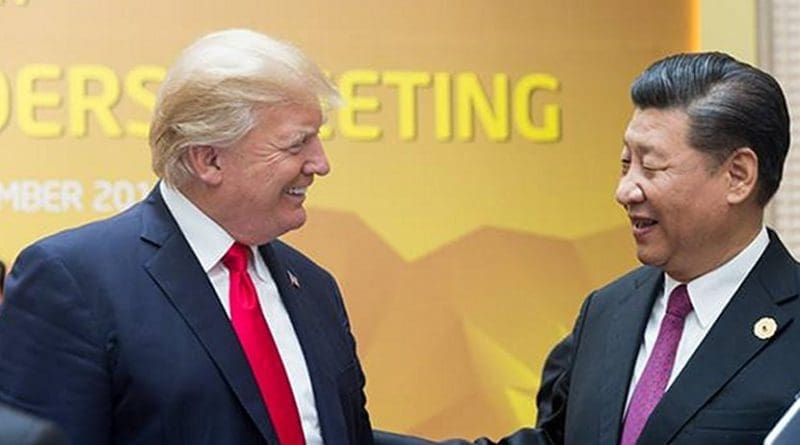US Containment Policy Towards China: Threats To Security In South Asia – OpEd
By Irfan Mahar
“The Future of Politics will be decided in Asia and the United States will be right at the centre of the action” — Hillary Clinton
South Asian region is home to a large population that faces multiple internal and external problems. The biggest challenge for South Asia as opined by various writers is peace and security. Former Advisor to PM on Foreign Affairs Sartaj Aziz emphasized on the need for South Asian political leadership to develop a clear narrative on security issues which are a great hindrance to the peaceful development and stability of the states of the region. Internally regional states have been experiencing instability, underdevelopment, poverty, corruption, illiteracy, sectarian conflicts, terrorism, and many other problems.
Externally the involvement of foreign powers also remains a big source of tensions throughout the region. Particularly, when it comes to the US-China relations and their security policies in South Asia which mostly revolve around three major factors i.e. human rights, trade, and security. Both Washington and Beijing have contending world views which lead them to the divergence of opinions concerning security interests in South Asia.
However, an interesting fact to note is that on one hand the United States considers China as a staunch adversary and on the other hand, they are major trade and business partners worth $737.1 billion during 2018 and worth $559 billion during 2019. Furthermore, the US introduced the policy of “Rebalancing or Pivot to Asia” which is considered as part of a greater strategy of containment of China. Beijing’s fast economic growth compelled the US, being a dominant power, to introduce a new policy that aims to contain the increasing Chinese influence in Asia via looking over the changing global economic, political, financial structures of the world. In this regard, Washington has been trying to engage with more nations in the South Asian region particularly India and Pakistan.
For containing Beijing, Washington adopts a two-pronged policy based on hard and soft power, United States has historically been involved in the South Asian region owing to multiple reasons such as Soviet invasion of Afghanistan, India-Pakistan nuclear tests, 9/11 incident, Washington-Delhi rapprochement, and above all for the containment of China.
The rise of Beijing compelled the United States to engage deeply with South Asian nations to limit Chinese influence and engagement, particularly with Delhi to create a balance of power in the region. In this regard, the Chinese factor became the major reason for Washington to make India an important trade and investment partner.
In addition to this, increasing strategic significance of the Indian Ocean with growing Chinese presence worried the US. The ocean provides direct access to the oil-rich Persian Gulf. As for Chinese policy concern toward the US, it pledges to opt the policy of hedging i.e. two contradictory policy directions simultaneously being pursued, which in this case are: balancing and engagement.
On one hand the state maintains a strong military, builds and strengthens alliances, while on the other hand it builds trade networks, increases diplomatic links, and creates multilateral frameworks. Hence, China projects soft power through Belt and Road Initiative (BRI) and tries to make more alliances. Moreover, China aims at changing the global structure in which the US has a dominant position through political, economic, and financial structures of the world. Moreover, Beijing particularly aspires to be the regional hegemon particularly in South Asia because of its near abroad and first testing ground for success of BRI project to become successful globally.
While the growing Indo-US nexus has posed serious threats to the security of the South Asian region. Pakistan, being a strategically important nation, could best serve American interest through being a part of American policies and actions in which Afghan issue and BRI keep much importance. Also, Washington keeps an attentive eye over Afghanistan and Iran in the region for limiting Chinese influence therefore it doesn’t want Iran and Afghanistan draw closer to China by being part of BRI. China and Iran share cordial relations but American sanctions over Iran create restrictions for Beijing to engage with Tehran for trade and other exchange of goods.
The presence of the US forces in Afghanistan, after 9/11, has worsened the security condition of the region. Because of this South Asian region has become fragile giving birth to multiple terrorist elements such as ISIS, Al-Qaeda, and Taliban rendering the region unstable and fragile. Moreover, Washington’s support for the Indian-led transport corridor project under development in Iran and Afghanistan results in growing Indian influence and involvement in both the countries. Resultantly Delhi misuses its influence and involvement in both states against Pakistan and carries out terrorist activities on Pakistan’s soil as is evident from the arrest of an Indian spy Kulbhushan Jadhav, who entered Balochistan, one of the provinces of Pakistan, from Iran with malicious aim of carrying out terrorist activities.
Therefore, all these acts of Washington to contain Beijing in South Asia gives birth to many security concerns in the region. Such as increasing interstate tensions between nuclear-armed neighbors India and Pakistan, insurgency, violent conflicts, and security problems ranging from militancy to organized crime which makes it more complex and insecure.
*The writer is working as a Research Associate at the Strategic Vision Institute (SVI), a non-partisan think-tank based out of Islamabad, and Ph.D. scholar in the Department of Defense and Strategic Studies, Quaid-i-Azam University Islamabad, Pakistan.

